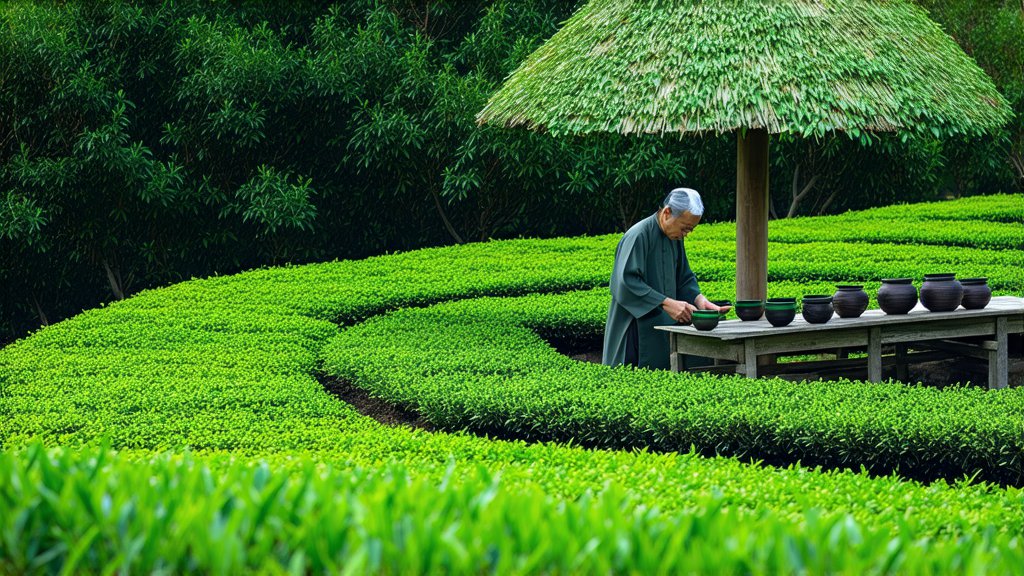
Nestled in the heart of Fujian Province's Anxi County lies a tea culture that has been perfected over centuries, giving birth to one of China's most revered oolong teas – Tieguanyin. This exquisite beverage, also known as "Iron Buddha" for its heavy, almost metallic taste profile, is not merely a drink but an experience steeped in history and tradition. Join us on a journey through the origins, varieties, craftsmanship, and nuanced appreciation of Tieguanyin, a true testament to the art of Chinese tea making.
Historical Roots and Legends
Tieguanyin's story begins in the early Qing Dynasty, around the 1720s, amidst the misty mountains of Anxi. Its name translates to "Iron Guanyin," referencing the Guanyin菩萨 (Bodhisattva of Mercy), under whose image the first tea bushes were discovered. According to local lore, a poor scholar named Wei Yin discovered these wild tea plants while studying for his imperial exams in a remote temple. Infused with spiritual significance, the tea gained popularity rapidly, becoming a symbol of purity, longevity, and enlightenment.
Varieties and Classifications
Tieguanyin falls under the broader category of oolong teas, which bridge the gap between green and black teas. It is characterized by its unique processing method that imparts both floral aromas and rich, complex flavors. There are several notable sub-varieties of Tieguanyin, each with distinct characteristics:
- Xiang Pian (Fragrant Type): Known for its high fragrance and lighter taste, Xiang Pian is often favored by those new to oolong teas.
- Yan Cha (Rock Tea): Grown on rocky terrains, Yan Cha boasts a more robust flavor profile with hints of mineral notes, reminiscent of its mountainous origins.
- Carbonized (Rou Gui): This variety undergoes additional roasting, resulting in a smoky, earthy flavor profile that appeals to seasoned tea connoisseurs.
The Craft of Tieguanyin Making
The creation of Tieguanyin is an intricate dance between man and nature, involving meticulous steps to preserve the tea's inherent qualities:
- Plucking: Only the tenderest buds and leaves are handpicked, typically during the morning hours when temperatures are cooler, ensuring optimal freshness.
- Withering: Leaves are spread out to wilt under the sun or in shaded areas, reducing moisture content and softening the cell walls for rolling.
- Fixation (Bruising): Leaves are lightly bruised in bamboo baskets to initiate oxidation, a crucial step in developing Tieguanyin's signature flavor.
- Shaping & Rolling: The leaves are then shaped into tight pellets, enhancing their appearance and aiding in even drying.
- Oxidation: Controlled oxidation occurs, where enzymes interact with oxygen, transforming the leaves' color and flavor profile.
- Roasting: Depending on the desired outcome, the tea may be roasted once or multiple times to further refine its taste and aroma.
- Sorting & Packaging: Finally, the tea is sorted by grade and carefully packaged to maintain its quality until it reaches the consumer.
Appreciating Tieguanyin: A Sensory Experience
Tasting Tieguanyin is akin to embarking on a sensory adventure. The traditional Gongfu tea ceremony, emphasizing precision and mindfulness, is the preferred method for savoring this tea:
- Preparation: Use a Yixing clay teapot or a Gaiwan (a lidded bowl) for brewing, along with small cups to capture the essence of each infusion.
- Water Quality: Use soft, mineral-rich water heated to approximately 90°C (194°F) to extract the best flavors without scalding the leaves.
- Leaf Quantity: Typically, 5-7 grams of loose leaves per 100ml of water is recommended for a balanced brew.
- Steeping Time: Short infusions of 15-20 seconds initially, gradually increasing with subsequent steepings, allow exploration of different flavor layers.
- Observation: Appreciate the tea's aroma before tasting, noting its evolving scent from floral to fruity to roasted notes.
- Tasting: Sip slowly, allowing the tea to coat your palate, and discern the balance between sweetness, bitterness, and astringency. Pay attention to the aftertaste and how it lingers.
- Multiple Infusions: Tieguanyin can be steeped multiple times, each revealing new facets of its complexity.
In conclusion, Tieguanyin embodies the essence of Chinese tea culture – a harmonious blend of tradition, artistry, and nature's bounty. Its journey from ancient legends to modern tea tables invites us to pause, reflect, and appreciate the simple yet profound pleasure of a well-brewed cup. As you delve into the world of Tieguanyin, remember that each sip carries with it centuries of history, a testament to humanity's enduring quest for perfection in the art of tea.